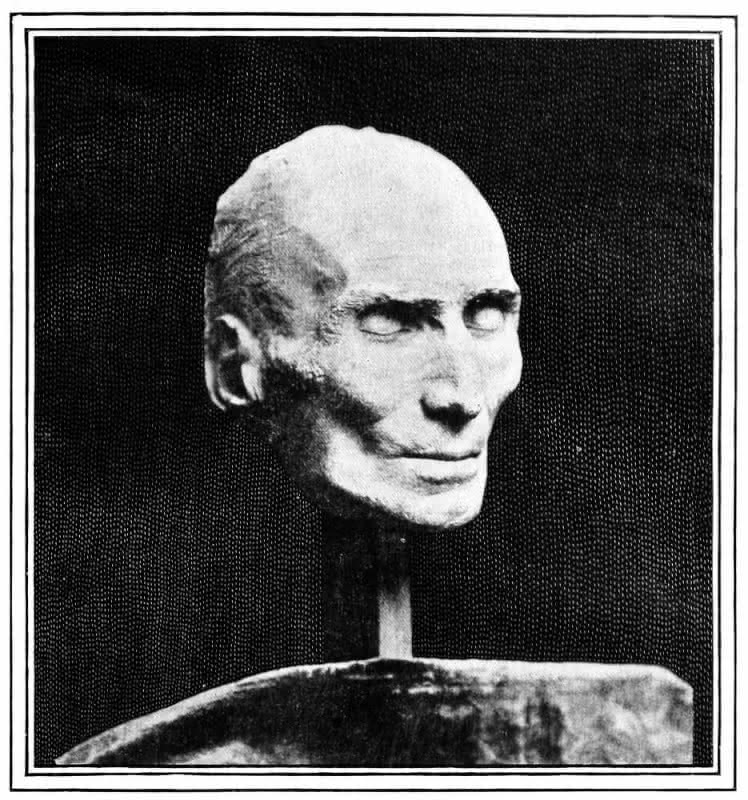James Monroe served as the fifth president of the United States from March 4, 1817 to March 4, 1825. Monroe breathed his last on July 4, 1831, the 55th anniversary of the ratification of the signing of the Declaration of Independence. Monroe was the third out of the first five presidents to die on July 4, joining his predecessors John Adams and Thomas Jefferson, both of whom passed away on July 4, 1826. I recently published an article on Monroe’s death and extraordinary life. In this post, I will continue with our Monroe theme – covering a chapter on a death mask of James Monroe, created by John Henri Isaac Browere, from Browere’s Life Masks of Great Americans (1899) by Charles Henry Heart.
Brief Introduction
John Henri Iasaac Browere was a New York City-based artist who lived from 1792-1835. As I detailed in a previous article, Browere was known primarily for his life masks of eminent Americans of the day and detailed busts based on those masks. Among the many great figures captured by Browere were former presidents John Adams, Thomas Jefferson, and John Quincy Adams, as well as then-future president Martin Van Buren. Browere never took a life mask of the fifth president, James Monroe. However, he did take a death mask of Monroe.
Monroe’s Death Mask
I will rely primarily on Charles Henry Hart’s chapter about Browere’s death mask of Monroe. You can follow along with the chapter on Project Gutenberg.
The Monroe death mask chapter stands in contrast to the rest of Hart’s book, which focused exclusively on Browere’s life masks. Hart made clear in the preface to the Monroe chapter that he compared death masks unfavorably to well-done life masks. See the following passage:
While it is possible to preserve ‘the spirit and expression’ as well as to give ‘the exact similitude of every feature’ in a life mask, as exemplified by the marvelous work of Browere, it is impossible in a death mask, for those evanescent qualities are then gone.
It is perhaps for that reason that Browere himself was not wont to create death masks. Hart noted that the Browere’s death mask of Monroe is the only death mask that he was known to have made. While Hart’s opinion of death masks was negative on the whole, he made a small exception for the quality of the Monroe mask:
[A]lthough it is open to much of the objection urged against death masks generally, it is superior to any other death mask I have ever seen.

Hart opined that it was “difficult to believe” that the death mask of Monroe, pictured above, “was made after life was gone…” In a testament to Browere’s ability, Hart stated that the death mask of Monroe “possesses more living, breathing qualities than the life masks made by other men.” I noted in my history of Browere’s work that he did not document his method for making life masks. Hart made reference to that in stating that “[i]f any proof were needed of the inestimable value of Browere’s lost process for making masks, it can be found in the quality of his death mask of James Monroe.”
However, for all of Hart’s praise of Browere’s death mask of Monroe, his praise was still circumscribed for he continued to hold death masks in low regard. Hart compared the Monroe death mask unfavorably to the extant portraits of a somewhat younger Monroe by Stuart and Vandelyn. He concluded by stating that while he had opined that Monroe’s death mask was “far more life-like than many life casts, its reproduction only serves to emphasize my views as to the little value of death masks as portraits.”
Views on Monroe in 1889
Hart’s book focuses on Browere’s depictions of historic figures more than the historic figures themselves. His chapter on Monroe includes an overview of Monroe’s life and accomplishments, but there is little in the overview that would be out of place in many readily available summaries of the fifth president. One sentence, however, struck me as interesting as a capsule of how Monroe was viewed in 1889, 64 years after he left the presidency.
Monroe’s name is perhaps more familiarly known to the public than that of any other President, save for Washington and Lincoln, owing to its association with the doctrine, which he promulgated, of non-interference on the western hemisphere by European nations, known as the ‘Monroe Doctrine.’
At the time Henry Hart wrote that Monroe was perhaps the third best-known American president, 25 men had held executive office, including the incumbent, then-President William McKinley. While I do not have the benefit of a survey, I will venture that a number of the first 25 presidents, including Washington and Lincoln (noted by Hart), are now better-known to the public (granting that American history and civics knowledge is somewhat lacking) than Monroe. At a minimum, I would assess that the first President Adams, Jefferson, Madison, Jackson, and Grant are better-known than Monroe, albeit with the exception of Jackson, not necessarily for their actions as president. I thought it was curious that Hart suggested that Monroe was better-known than Jefferson and Jackson, but perhaps that was the case in 1899 (I assume that Hart was implicitly omitting the presidents who had served recently and were thus still within ready memory).